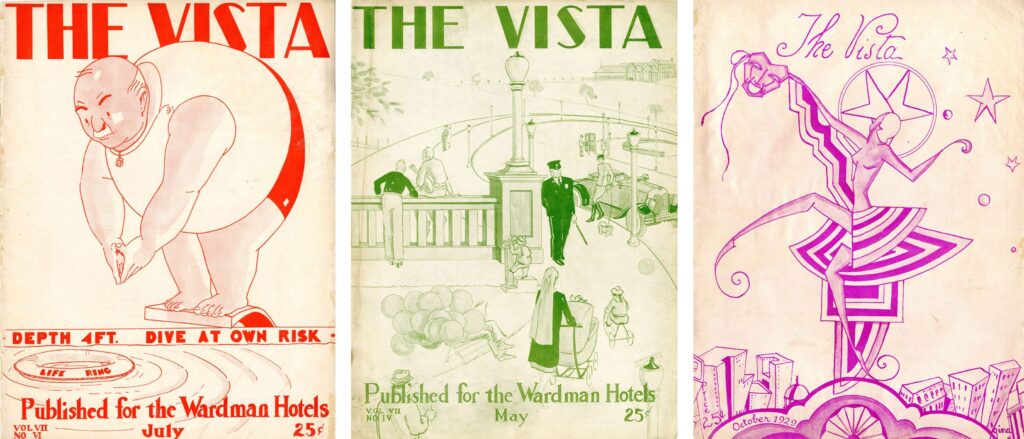This blog was adapted from the latest edition of our Washington History magazine series “On the Shelf: The Vista Magazine, 1924-1930, P 7499” by Senior Manager of Collections, Autumn Kalikin.
You can read her unabridged article in the fall 2023 issue of Washington History magazine.
Purchasing a copy of the Vista in 1920s Washington, DC was an investment in the finer things. For 25 cents well-off readers, or those aspiring to be, could peruse fashion advice, debutante announcements, market assessments, and reflections on the times. Published monthly by the Wardman Park Hotel, the magazine kept its audience abreast of the Roaring Twenties social scene without tasteless gossip, or so it claimed. Self-referential and irreverent, it covered current events and famous guests with biting commentary. Stunning covers in contemporary styles, like Art Deco, opened each issue, which assembled illustrations of women’s fashion, cheeky cartoons, and detailed advertisements. The DC History Center’s collection includes issues from 1924 through 1930, with most published between March 1929 and August 1930. Few copies and little information on their production remains. But within its pages and between the lines, the Vista offers a peek inside the District’s early 20th-century hospitality industry and the clientele it served.
From its lofty perch at 2600 Woodley Road NW, the original Wardman Park Hotel surveyed the surrounding area for decades. The luxurious English Colonial Revival structure opened on November 23, 1918, as the Wardman Park Inn with over 1,200 rooms and many residential apartments. Reported as “the largest private building operation ever undertaken in this city,” the five-million-dollar project attracted widespread interest and, initially, criticism. Its founder, Harry Wardman, was a prolific developer in the region, ever ambitious, he pursued the massive hotel’s construction despite opposition to its (then distant) location in Northwest. [1]
Far from DC’s most developed areas, the hotel provided for residents’ many needs in-house. It is little wonder that the property also published its own local magazine. [2]

Photo: Covers of The Vista magazine. Photos by Anne McDonough.
Evolving Stories at the Turn of the Decade
Virgila Stephens created and edited the Vista from its debut in March 1923 through March 1929. In March 1929, Clinton Newton Howard took over as editor, adjusting the Vista’s content for a broader, but still wealthy and largely White, audience. Longer articles appear in 1929 and 1930 on local gossip, finances, technological advances, artist profiles, satirical social commentary, book reviews, and updates on the development of future Wardman hotels. [3]
Chock full of opinions, the Vista’s later issues ran several social commentary pieces. The satirical column “Barbarism Declines” sardonically eulogizes the flapper archetype in April 1929, depicting her as aged and decrepit. The author welcomes the 1930s with its promised “return to civilization.” Embedded in another article is the poem “How to Be a Successful Debutante,” which begins “To be a proper debutante/ One first should have a wealthy aunt, / Twelve dresses, and a tub of gin/ To drown unwelcome suitors in.” [4]
While such content is out of place today, 21st-century readers will find some familiar topics in the Vista. Concerns about space for automobile parking, record-breaking heat waves, and anxieties over “market uncertainties” pack its pages. A once reliable entry, the “Investments” column is noticeably absent beginning in November 1929, the first issue published since the October stock market crash. In its place, the Vista covered lighter topics, like “Speaking of Dogs,” introduced in December 1929 for local canines’ companions. [5]
The Impact of the Great Depression
With longer social sections, no doubt distracting from the Great Depression, the magazine still went to press in 1930. Wider, empty margins contrasted with previous issues’ wall-to-wall text, signaling the effects of the financial downturn. Meanwhile, all was not well with Harry Wardman, who suffered significant losses to his fortune in Black Tuesday’s collapse. Unable to meet his financial obligations, he signed over all his holdings to the Hotel Management and Securities Corporation in August 1930. The DC History Center holds no further issues beyond this date, and with no evidence to the contrary, they may have been the magazine’s final installments.
Over the next 90 years, the Wardman Park property changed hands many times. Branded the Sheraton-Park Hotel in 1953, it experienced several expansion projects throughout the 1960s and 1970s and became the Marriott Wardman Park Hotel in 1998.
Once again the Wardman Park property faces redevelopment. Its shifting landscape embodies Washington, DC’s built environment as palimpsest, one that is constantly being built, rebuilt, demolished, and restored. The historical character of these sites is not skin deep and perseveres through the material culture they leave behind.
Fifteen issues of the Vista magazine are available for reference at the Kiplinger Research Library, by appointment.
Autumn Kalikin is the Senior Manager of Collections of the DC History Center.
[1] “Mammoth Hotel Opens This Evening,” Evening Star, Nov. 23, 1918.
[2] “Society,” Evening Star, Nov. 25, 1919; ” Happenings in Capital Society,” Washington Times, Dec. 19, 1919.
[3] Bill Hogan, “The First Tycoon,” billhogan.com/1981/05/the-first-tycoon/.
[4] “Barbarism Declines,” Vista, Apr. 1929, 4; Michael Allen, “Haven’t You Heard? Being a Scathing Denunciation of Washington Tittle-Tattle and an Exposé of the City’s Social Classes,” Vista, June 1929, 7; George Abell, “How to be a Successful Debutante,” Vista, June 1927, 7.
[5] Frank Patton, “Speaking of Dogs,” Vista, Dec. 1929, 29.